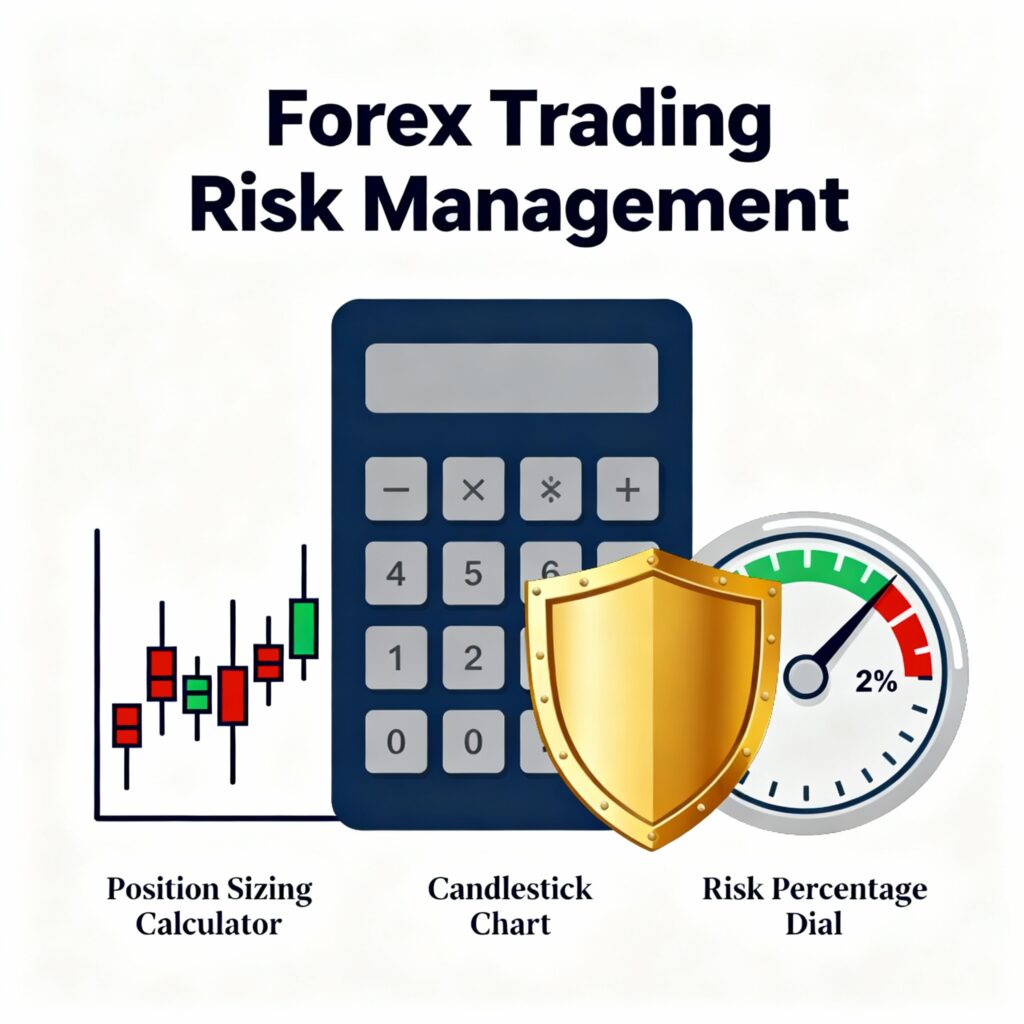The harsh reality of forex trading reveals itself not in the moments of victory, but in the inevitable periods of drawdown when equity curves bend downward and psychological pressure mounts. Most traders approach position sizing as an afterthought, focusing instead on entry signals and technical patterns. This inverted priority structure explains why the majority of retail forex accounts deplete within their first year of trading.
Position sizing represents the single most critical determinant of long-term survival in forex markets. It functions as the mathematical governor that prevents catastrophic losses while allowing sufficient exposure to capture meaningful returns. The difference between a trader who survives a 30% drawdown and one who suffers terminal account damage often comes down to position sizing methodology rather than analytical skill.
The Mathematical Foundation of Survival
Before examining specific position sizing methods, we must understand the asymmetric mathematics of losses and gains. A 50% loss requires a 100% gain to restore original capital. This asymmetry creates a fundamental constraint: preservation of capital must supersede profit maximization. Any position sizing system that ignores this mathematical reality will eventually encounter a sequence of losses that proves insurmountable.
Consider a trader starting with 10,000 USD. After losing 50% through oversized positions, they possess 5,000 USD. To return to breakeven, they must now generate 100% returns on remaining capital. The psychological and practical difficulty of this task increases exponentially with drawdown magnitude. Once drawdown exceeds 70%, recovery becomes statistically improbable within reasonable timeframes.
Effective position sizing operates as a probability-weighted risk management system. It accounts for the statistical distribution of returns, the serial correlation of losses, and the psychological capacity of the trader to maintain discipline under adverse conditions.
Fixed Fractional Position Sizing
The fixed fractional method represents the most widely applicable position sizing approach for forex traders. Under this system, the trader risks a predetermined percentage of current account equity on each trade. Common risk percentages range from 0.5% to 2% per trade, with more conservative traders selecting lower values.
The mechanics operate straightforwardly. A trader with 10,000 USD equity who risks 1% per trade allocates 100 USD to each position. The position size in lots derives from this risk amount divided by the stop loss distance in pips multiplied by pip value. If the stop loss sits 50 pips from entry and each pip equals 10 USD per standard lot, the calculation yields: 100 USD / (50 pips × 10 USD per pip) = 0.2 standard lots.
This method possesses significant advantages. It automatically adjusts position size proportionally to account balance, reducing exposure during losing streaks and increasing it during winning periods. The mathematical structure ensures that the account can never reach zero through a finite number of losses, though it can approach zero asymptotically.
The primary weakness emerges during extended drawdowns. As equity decreases, position sizes shrink proportionally, potentially creating a situation where profitable trades generate insufficient returns to offset previous losses. A trader experiencing a 20% drawdown must now win back 25% of remaining capital just to breakeven, with smaller position sizes making this task more challenging.

The Kelly Criterion and Its Limitations
The Kelly Criterion offers a mathematically optimal position sizing formula derived from information theory. The basic Kelly formula states: f = (bp – q) / b, where f represents the fraction of capital to risk, b equals the ratio of win to loss size, p represents win probability, and q equals loss probability (1-p).
For a trading system with 60% win rate and 1:1 risk-reward ratio, the Kelly Criterion suggests risking 20% per trade: f = (1×0.6 – 0.4) / 1 = 0.20. This recommendation immediately reveals the formula’s primary limitation in forex trading. Risking 20% per trade exposes the account to catastrophic drawdown risk. A sequence of five consecutive losses, which occurs regularly even with 60% win rate systems, would destroy 67% of account equity.
Experienced traders employ fractional Kelly sizing, typically one-quarter to one-half Kelly, to mitigate this volatility. Half-Kelly sizing for the previous example yields 10% risk per trade, still aggressive but more survivable. Quarter-Kelly at 5% risk per trade begins approaching practically useful territory for forex applications.
The Kelly Criterion’s theoretical elegance encounters practical obstacles in forex markets. Accurate estimation of win probability and average win-loss ratios requires extensive historical data and assumes these parameters remain stationary over time. Market regime changes invalidate these assumptions regularly. Furthermore, the formula assumes independent trials, while forex returns exhibit serial correlation during trending and mean-reverting market phases.
Fixed Ratio Position Sizing
The fixed ratio method, popularized by futures trader Ryan Jones, addresses some limitations of fixed fractional sizing during drawdown recovery. This approach increases position size only after generating a specified dollar amount of profit per existing contract or lot.
The trader selects a delta value representing the profit required to add one additional lot. With a 5,000 USD delta, the trader begins with one mini lot. After generating 5,000 USD profit, they increase to two mini lots. The next increase occurs after an additional 10,000 USD profit (5,000 USD per lot × 2 lots), reaching three mini lots at 15,000 USD total profit.
This method creates an accelerating equity curve during winning periods while maintaining more conservative sizing during initial stages and after drawdowns. The delta parameter functions as a risk control mechanism, with larger deltas creating more conservative progression.
Fixed ratio sizing performs well for trend-following systems that generate occasional large winners. The gradual position size increases allow the trader to capitalize on extended favorable market conditions without overexposing the account during consolidation phases. However, the method requires discipline during drawdowns, as position sizing may not decrease quickly enough if losses occur after recent increases.
Volatility-Adjusted Position Sizing
Professional forex traders often incorporate volatility normalization into position sizing calculations. This approach recognizes that a 50-pip stop loss during low volatility conditions represents dramatically different risk compared to the same stop loss during high volatility periods.
The Average True Range (ATR) provides a straightforward volatility measurement. A trader might establish a rule to risk a fixed number of ATR units per trade rather than a fixed pip amount. For example, risking 2 ATR on each trade automatically adjusts stop loss distance to current market conditions.
When the 14-period ATR for EUR/USD equals 60 pips, the stop loss sits at 120 pips (2 × 60). If volatility increases and ATR expands to 90 pips, the stop loss widens to 180 pips. The position size decreases proportionally to maintain constant dollar risk, assuming the trader continues risking 1% of equity per trade.
This methodology prevents the common mistake of using fixed pip stops across varying volatility regimes. A 50-pip stop might provide reasonable protection during calm markets but proves inadequate during volatile periods, leading to premature stop-outs. Conversely, maintaining wide stops during low volatility periods unnecessarily reduces position size and potential returns.
Volatility-adjusted sizing integrates naturally with fixed fractional risk management. The trader first calculates dollar risk based on account percentage, then determines position size based on ATR-derived stop loss distance. This combined approach addresses both account-level risk and market-specific conditions.
Correlation-Adjusted Position Sizing
Sophisticated forex traders account for correlation between currency pairs when sizing positions. Taking simultaneous positions in EUR/USD and GBP/USD effectively concentrates risk, as these pairs exhibit strong positive correlation. The dollar represents the common element, and both European currencies often move in tandem relative to the US dollar.
A trader risking 1% per position who opens long positions in both EUR/USD and GBP/USD may believe they’re risking 2% total. However, if correlation stands at 0.8, the effective risk approaches 1.6-1.8% on a single directional bet against the dollar. During periods when these pairs move in lockstep, both positions may hit stop losses simultaneously.
The correlation-adjusted approach reduces position sizes proportionally to correlation strength. A simplified method multiplies the standard position size by the square root of (1 – correlation coefficient). For pairs with 0.64 correlation, the adjustment factor equals sqrt(1 – 0.64) = 0.6, reducing position size to 60% of the uncorrelated baseline.
This calculation extends to portfolios of multiple pairs. A trader running positions across six major pairs must calculate the correlation matrix and adjust total exposure to maintain desired portfolio risk levels. While mathematically intensive, this approach prevents the hidden leverage that accumulates when multiple correlated positions align unfavorably.
Heat Mapping and Portfolio Risk
Professional trading operations implement heat mapping systems to visualize aggregate portfolio risk. Heat refers to total capital at risk across all open positions. A trader with three positions, each risking 1%, maintains 3% heat. This simple metric provides immediate insight into portfolio exposure.
Maximum heat limits prevent overexposure during periods of high opportunity perception. A trader might establish a 5% maximum heat rule, limiting total open risk regardless of identified trade opportunities. When heat reaches 5%, new positions require either closing existing trades or waiting for stops to move to breakeven.
This systematic approach counters the natural human tendency to increase exposure during confident periods, which often coincide with late-stage trends and impending reversals. The heat limit functions as a circuit breaker, enforcing discipline when psychological pressure to overtrade intensifies.
Dynamic heat adjustment based on recent performance adds sophistication. After a 10% drawdown, maximum heat might reduce from 5% to 3%, decreasing exposure until the equity curve stabilizes. Following a 10% equity increase, maximum heat might expand to 6%, allowing slightly increased exposure during favorable conditions.
Time-Based Position Sizing
The temporal dimension of trading often receives insufficient attention in position sizing discussions. Identical position sizes carry different risk profiles depending on intended holding period. A position sized for a 50-pip swing trade represents excessive risk for a 500-pip position trade, as the longer timeframe position faces more overnight gaps, news events, and regime changes.
A practical implementation separates capital into timeframe buckets. A trader might allocate 50% of capital for day trades, 30% for swing trades lasting several days, and 20% for position trades lasting weeks. Each bucket operates with independent risk rules appropriate to its timeframe.
Day trading buckets tolerate higher per-trade risk percentages, perhaps 1-2%, as positions close before overnight risk materializes. Swing trade allocations might reduce to 0.5-1% per trade, accounting for overnight gaps. Position trade buckets require conservative 0.25-0.5% risk per trade, reflecting the extended duration and multiple event risks.
This segregation prevents the common error of applying day trading risk parameters to longer-term positions. It also creates psychological benefits by separating different trading strategies, reducing interference between timeframes and allowing clearer performance attribution.
Surviving the Inevitable Drawdown
Every trading system, regardless of sophistication, encounters drawdown periods. The difference between professionals and amateurs manifests in drawdown response. Amateurs increase position sizes attempting to recover losses quickly, accelerating account deterioration. Professionals decrease exposure, focusing on capital preservation until conditions improve.
A formal drawdown protocol establishes clear rules for position size reduction. When equity drops 5% from peak, reduce position sizing by 25%. At 10% drawdown, reduce by 50%. At 15% drawdown, reduce by 75% or cease trading entirely pending system review. These predetermined rules eliminate emotional decision-making during psychologically difficult periods.
The mathematics supporting drawdown reduction are compelling. A trader experiencing a 10% drawdown needs 11.1% returns to recover. If they reduce position sizing by 50% during this period, recovery takes longer but preservation of remaining capital takes priority. The alternative, maintaining or increasing position size, risks extending the drawdown to 20%, requiring 25% returns to recover, or worse, 30% drawdown requiring 43% returns.
Drawdown reduction protocols include time-based elements. If drawdown persists beyond a specified duration, such as three months, progressively reduce position sizing regardless of drawdown magnitude. Extended drawdowns suggest potential system degradation or market regime change, warranting defensive posture until conditions clarify.

Monte Carlo Simulation for Position Sizing Validation
Before implementing any position sizing methodology in live trading, Monte Carlo simulation provides essential validation. This technique randomly resamples historical trade sequences to generate thousands of alternative equity curves, revealing the range of possible outcomes.
A trading system with 100 historical trades undergoes Monte Carlo analysis by randomly selecting trades with replacement, creating new 100-trade sequences. Repeating this process 10,000 times generates 10,000 alternative equity curves. Analysis of these curves reveals maximum drawdown distribution, probability of ruin, and return distribution under various position sizing schemes.
The trader tests position sizing from 0.5% to 3% per trade, observing how maximum drawdown and probability of ruin change. Results typically show that doubling position size more than doubles maximum drawdown and dramatically increases ruin probability. This empirical evidence guides selection of position sizing parameters that balance growth objectives against survival probability.
Monte Carlo simulation also reveals sequential risk. Some position sizing methods perform well on average but exhibit catastrophic performance in specific trade sequences. By examining the worst-case equity curves from the Monte Carlo output, the trader identifies position sizing approaches that demonstrate robustness across diverse scenarios.
Practical Implementation in Automated Systems
Translating position sizing theory into executable code requires attention to practical details. Automated trading systems must account for minimum lot sizes, broker margin requirements, and execution latency. A theoretically optimal position size of 0.173 lots cannot execute if the broker requires 0.01 lot increments.
The implementation begins with calculating theoretical position size using chosen methodology, then applies rounding rules to match broker specifications. Conservative rounding always rounds down, ensuring actual risk never exceeds calculated risk. A theoretical 0.176 lots rounds to 0.17 lots, slightly reducing risk.
Margin calculations present additional complexity. The position size that satisfies risk requirements may exceed available margin, particularly for accounts with existing positions. The system must check available margin before order submission and reduce position size if necessary to maintain adequate margin buffer.
Slippage modeling adds realism to position sizing calculations. In live markets, execution prices differ from theoretical prices due to spread and market impact. Conservative position sizing incorporates estimated slippage into risk calculations, further reducing position size to ensure actual risk aligns with intended risk after execution costs.
The Psychological Dimension
Position sizing directly influences trading psychology, yet this aspect receives limited discussion. Oversized positions generate stress and anxiety, interfering with rational decision-making. Undersized positions create opposite problems, encouraging careless analysis and overtrading due to low perceived risk.
Optimal position sizing produces psychological equilibrium. The trader maintains emotional detachment from individual trades, viewing each position as one iteration in a long statistical series. Stop loss hits provoke no emotional reaction beyond noting the data point. This psychological state emerges only when position sizing aligns with personal risk tolerance.
Personal risk tolerance varies significantly between individuals and changes over time. A new trader requires more conservative position sizing than a veteran with years of experience managing drawdowns. Account size also influences psychological tolerance; a 2% loss feels dramatically different on a 10,000 USD account versus a 1,000,000 USD account.
Regular psychological assessment helps maintain appropriate position sizing. If stop losses trigger emotional distress, position size exceeds psychological capacity regardless of mathematical calculations. If individual trade outcomes feel insignificant, position size may be too small to maintain analytical discipline. Continuous calibration of position size to psychological state optimizes both performance and sustainability.
Integration with Trading Systems
Position sizing does not exist in isolation but integrates with broader trading system architecture. A mean-reversion system requires different position sizing approaches than a trend-following system. Mean-reversion strategies typically exhibit high win rates with occasional large losses, suggesting more aggressive base position sizing with strict maximum loss limits. Trend-following systems show lower win rates with larger average winners, benefiting from more conservative per-trade risk with allowance for position pyramiding.
System expectancy calculations inform position sizing decisions. A system with positive expectancy of 0.3R per trade (where R equals initial risk) can sustain larger position sizes than a system with 0.1R expectancy. Higher expectancy provides greater margin for error and faster drawdown recovery.
Position sizing also adapts to detected market regimes. During trending regimes, trend-following systems might increase position sizing by 25% while mean-reversion systems decrease by 25%. During ranging regimes, these adjustments reverse. Regime detection adds complexity but substantially improves risk-adjusted returns by aligning position sizing with favorable conditions for each strategy type.
Conclusion
The path to sustainable forex trading success runs through rigorous position sizing methodology. While market analysis and entry timing receive disproportionate attention from developing traders, position sizing determines survival during inevitable adverse periods. The methods presented here, from fixed fractional basics through advanced correlation adjustment and drawdown protocols, provide frameworks for building robust position sizing systems.
No single methodology proves universally superior. The optimal approach depends on trading strategy characteristics, personal risk tolerance, account size, and market conditions. Sophisticated traders often combine multiple methods, using fixed fractional sizing as a baseline with volatility adjustments, correlation corrections, and dynamic drawdown protocols layered on top.
The common thread through all successful position sizing systems remains unwavering adherence to the risk-first principle. Protecting capital during drawdowns takes absolute priority over maximizing returns during favorable periods. This conservative foundation paradoxically enables superior long-term performance by ensuring survival through complete market cycles. Traders who internalize this principle and implement appropriate position sizing methodology dramatically increase probability of joining the small minority who achieve sustainable profitability in forex markets.




